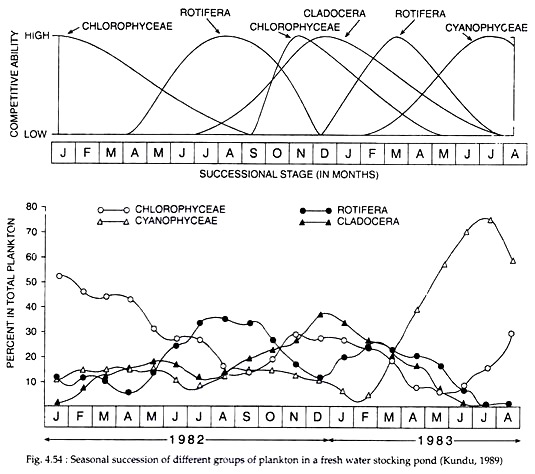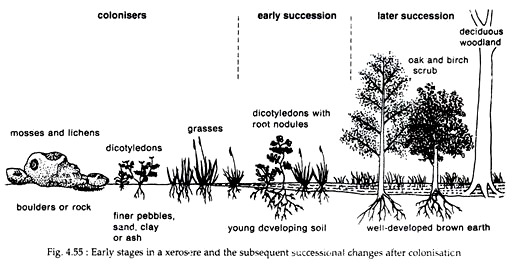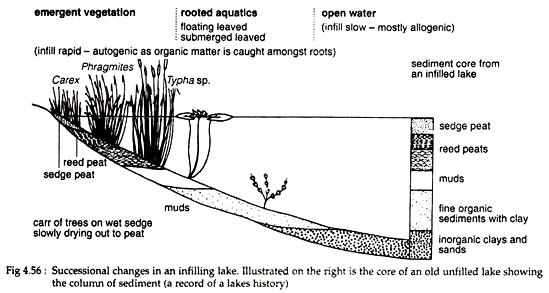In this article we will discuss about:- 1. Meaning of Succession 2. Sequences of Succession 3. Types 4. Causes 5. Examples 6. Species Diversity.
Meaning of Succession:
Most communities appear to be stable and unchangeable. However, when observed over a large period of time, they seem to be in a constant state of flux, where organisms die out and their place is taken up by other organisms. Energy and nutrients also take their course in the community.
The changes in the community occur very slowly if it is not disturbed. But when forest fire, deforestation and other disturbances occur, the habitat gets disturbed and the community rebuilds itself. The pioneer species gets replaced by other species and another community establishes itself.
Often swamps remaining under water for hundreds of years would turn into shallow lakes. The reverse can also occur, that is, when shallow lake dries out it is invaded by Taxodium and gets converted into a swamp land.
ADVERTISEMENTS:
Such continuous, unidirectional, sequential change in species composition of a natural community initiated by disturbance is called succession. Succession is often taken to mean changes in plant alone. Subsequently, other organisms associated with the vegetation types also change. The concept of vegetation succession was proposed by Frederic E. Clements in 1916.
Sequences of Succession:
The community that at first develops is called a pioneer community. Pioneer communities are made up of relatively few species that are able to immigrate and can live under an often extreme environmental condition. For the first couple of years annual herbs may be important. They are soon replaced by perennial herbs.
The perennial herbs establish themselves and spread by vegetative means. This herb stage is subsequently replaced by shrubs. The communities that follow are dominated by a forest of light-tolerant trees. The trees may invade the area along with the shrubs and for several years they are not too tall. They gradually become taller and the structure of the community changes.
The light-tolerant trees are unable to reproduce in the shade as they are shade-intolerant. Thus, the shade-tolerant species invade the area. Subsequently, a community develops in which the canopy trees are mainly shade-intolerant species and the lower layers are occupied by the shade- tolerant species. The community is thus at or near climax.
ADVERTISEMENTS:
The entire story from a bare land to a climax community is called successional series or a sere and the various communities existing at different times is called serai stage. Thus, the following serai stages (as discussed above) may be recognised— annual herb, perennial herb, shrub, early forest and ultimately the climax forest.
Types of Succession:
A. Classification based on water relationship:
Seres may be classified depending on the water relations of the site where they begin. A sere beginning in water is termed as hydro-sere. For example, it refers to the series of aquatic communities found in a lake. A successional sequence beginning in a place where there is a deficiency of water such as sand dunes, bare rock etc. is termed as Xerosere. The type of xerosere developing on rocks is called a lithosere.
B. Classification of seres according to their origin:
ADVERTISEMENTS:
Succession may begin on a totally bare area that had never before supported a community, such as sand dunes, lava flows, rock bared by erosion or exposed by a receding glacier etc. Succession occurring in such newly formed area is called primary succession, and the sere is a prisere.
Succession may occur on areas that have already supported a community such as an abandoned cropland (which is allowed to re-vegetate) or areas hit by Tsunami or tornado or a piece of burned-over forest land. The return of an area to its natural vegetation following a disturbance is called secondary succession, and the sere is a sub-sere.
The rate of secondary succession is usually faster than that of primary succession, because in the former case the soil is developed and contains seed and sprout able roots intact. However, just the reverse takes place in case of severe fire, where the organic layers of the soil get burnt and all biological species get destroyed.
Micro-sere:
All communities (serai or climax), in particular microhabitats, support a sequence of population forming a micro-sere. Microseres are minor successional sequences that occur within the framework of a larger community.
They have no separate climax stage of their own and, ultimately, get erased from the larger community. For example, when a forest tree gets uprooted, sequence of changes occur as the tree disintegrates, decays and eventually becomes indistinguishable from the forest floor.
Causes of Succession:
Succession may take place from changes brought about in two ways:
A. Autogenic succession:
Succession resulting from changes brought about by the organisms within the community is called outogenic succession. Example of autogenic succession is an abandoned agricultural field to a mature forest or filling-in of a pond by rhizomes and organic detritus etc. Autogenic succession brings about changes in the soil caused by the organisms growing there.
ADVERTISEMENTS:
The changes are accumulation of organic matter in the litter or humic layers, alteration of soil nutrient status or change in pH. Organisms themselves can bring about changes in environment in which they live. This may lead to harmful or beneficial effect on other species in the community.
Harm may also befall on the organisms making the change, resulting in their loss from the community. These changes may also create new ecological opportunities for species that are not in the community but may enter it through dispersal. Autogenic factors are immigration, growth, reactions, and coactions.
B. Allogenic succession:
Succession occurring due to forces of change occurring primarily from outside the community is called allogenic succession. Succession on bare rock may cause breakdown of the rock by organisms or by physical and chemical weathering. These latter processes are allogenic. In pond succession, the filling in by sand, silt and clay carried from outside the area is an allogenic factor.
Allogenic changes are caused due to external environmental influences and not by the vegetation- External forces may include massive disturbance such as climatic changes, or daily or seasonal changes in temperature and other environmental factors. In fresh water lakes and ponds, communities of plankton may undergo succession each year due to seasonal changes in temperature and light intensity (Fig. 4.54).
Soil changes due to leaching, erosion or the deposition of silts and clays alter the nutrient content and water relationships in the ecosystem. Animals can also be important as pollinators, seed dispersers and herbivores.
They may also be responsible for the increases of soil nutrient in certain areas or shift the soil (like termites, ants and moles) creating patchiness in the habitat. Allogenic changes occurring from climate change may occur over many thousands of years.
Autogenic and allogenic successions may occur simultaneously. The relative importance of the two depends upon the time scale of the allogenic changes. In response to gradual changes of the environment, as allogenic changes take a longer period of time to occur, the autogenic succession then is likely to be the most important factor determining the community structure. On the other hand, allogenic succession is likely to be the most important force of community change when disturbances occur frequently.
Role of reactions:
As has been pointed above in autogenic succession that the reaction of organisms (generally the dominant ones) of each successional stage make the area relatively less favourable for them selves, resulting in loss from the community. , The environmental change may be harmful or beneficial to other species in the community or favourable for organisms of the next stage.
For example, addition of nitrate to the soil by plants with associated nitrogen fixers made it favourable for invasion of organisms with higher nitrate requirement. Such processes continue till the climax stage is reached and the community is composed of organisms who are able to tolerate their own reactions. According to Clement, reactions are especially significant as they are the driving force of succession.
In succession there are areas- worthy for study, such as:
(1) How different species arrive in succession and how they increase, and
(2) The degree to which early species in succession make conditions more worthy for the later successional species.
Depending on the nature of reaction three possible models can be distinguished:
1. Facilitation model:
Reactions of earlier species make the environment more suitable for later successional species.
2. Tolerance model:
Reactions of earlier species have little or no effect on the growth of the later species.
3. Inhibition model:
Reactions of earlier species make the environment less suitable for later species.
All three situations occur in nature and may occur in the some sere.
Role of Coactions:
In succession the role of coaction is also important. Coaction is the interaction within the community of living organisms – the effect of organism on organisms. Competition for light and space often leads to replacement of earlier species of plants by later ones. Many changes in animal species are probably the result of competitive coactions.
Noncompetitive coactions are also important in succession. Presence or absence of animal species depends partly on the microclimate and partly on the provision by plants, such as elevated branches for perching, trees suitable for nesting, availability of appropriate nesting material etc. (The role of noncompetitive coactions by animals and fungi in determining what the dominant species are and their rate of replacement is probably substantial). The spread of many trees like oak, pines, banyan, beeches and many others into another area is dependent upon dispersal animals like squirrels, birds etc.
Animal’s role in coaction can also be stressed upon the kind of plants they eat or do not eat. In pastures the cattle, horses etc. do not generally eat thorny plants. Rabbits also have their preferences for browsing preferring oaks and allowing black cherries and elms to dominate the early tree stage of some seres. Host of examples are present stressing the role of coaction in succession.
Examples of Succession:
A. Xerosere:
Xerosere is the sequence of colonisation by organisms on dry land. The melting of ice sheets created vast expanses of ground where primary xerosere could occur. This process of melting had taken place many years back (about 13,000 years ago) and the understanding of the primary colonisation and later sequences comes form the direct observations of recently exposed site and from fossil records.
The process of succession is usually initiated by the invasion of autotrophs. Fig. 4.55 shows a summary of the primary stages in a xerosere on exposed glacial surfaces. The ground may be formed of solid rock or of very large boulders. So there will be no root- forming plants.
The pioneer species would be mossess or lichens as they can cling to the rock surface. The buildup of the soil follows in shallow depressions or cracks on the rocks. This encourages the growth of vascular plants. The whole process is very slow and may take hundreds or thousands of years.
Instead of the rocky ground surface, if finer particles such as silts or clays are present then the pattern of colonisation is quite different from the above. The substratum having more water balance can be penetrated by roots and so the vascular plants colonies immediately. The dicotyledonous herbs or grasses invade the area if the site is nutrient rich. The second community in this- site would be rich in plants with nitrogen-fixing bacteria held in root nodules.
As the grass and herb mixture in the xerosere is invaded by scrub bushes, they form ideal site for roosting birds. The invasion of scrub is, however, a slow process. The birds deposit many seeds on the site and their droppings make the soil rich in nutrients.
Colonizing trees such as wind dispersed birches (Betula sp.) and bird dispersed oaks (Quercus sp.) may establish themselves at this stage. They are the pioneer trees and require high light intensity for their seedlings to establish. Once woodland is established, the shade tolerant species invade the area and it leads to the establishment of climax community.
B. Hydro-sere:
Successional sequences which develop in aquatic environment such as in lakes are called hydroseres. When ice retreated, new lakes were formed. These lakes started accumulating inorganic particles like sand, clay etc. washed in from outside.
Pioneer plants then starts developing and the infilling of the lakes slowed down. The early changes in plant succession are very slow as the deep lakes have to become shallow enough for the rooted plants to grow.
Colonisation of surface water takes place by free-floating aquatic plants like duckweeds (Lemna sp.), Pistia etc. and by the algaes Chara. At the edges of the lake where light can reach the sediment, submerge plants like Potamogeton and Myriophyllum grow. These plants increase the productivity and biomass of the lake.
The lake becomes sufficiently shallow and floating-leaved plants begin to grow, such as lilies (Nuphar and Nymphaea). The large surface areas of the leaves of lilies cut off the sunlight and reduce the submerged plants, which die, decay and accumulate at the lake bottom as organic mud.
Emergent vegetations like Phragmites and Typha invade the area. The leaf litter formed by these plants is resistant to decomposition and results in the formation of reed peat. This peat gets raised from the ground above the water surface and the community changes again to the one dominated by sedges (Carex sp) and sedge pit is thus formed.
The sedge pit accumulates above the water level, gets no longer water lodged and is then invaded by trees like alders (Alnus) and willows (Salix). As the last stage in the hydro-sere, the development of wet woodland (called fen carr) takes place.
Often many of the above communities can be seen together. Fig. 4.56 depicts a hydro-sere of a lake. The right hand side of the figure shows what a core taken from such a lake might show. Terrestrial seres, however, do not show such a permanent record of successional changes, as its top soil changes and gets reworked rather than building up in a sequence. Thus, more accurate information about succession can be obtained from a hydro-sere than that from a xerosere.
C. Succession after a fire outbreak:
Fire may be rare or common but its effect are not devastating. Communities respond to it with patterns of regrowth and regeneration which are often more or less predictable. In some habitat the structure of the community is maintained by periodic fires. The characteristic of fire disturbance is its intensity which is dependent upon the nature of the community itself when the fire broke and its different flammabilities.
The intensity of fire is also dependent upon a number of factors – moisture content, direction and strength of wind etc. The nature of damage also are variable that is it may burn close to the ground or it may damage organic material in the soil or it may cause damage to the canopy of trees.
After the fire has receded, the light and rapid growing seeds of species invade the area and establishes itself. Successive interactions of communities with the environment results in successive interactions of communities with the environment results in successive changes through time and gives rise to a series of different communities.
Fire is a classic example of secondary succession. The post-disturbance communities develop and colonies from remote areas. Many plants like pitch, oak etc. can withstand the heat of the fire and may survive. In case of jack pine, the cones on catching fire may open up releasing the seeds, a phenomena called serotiny.
In some cases, fire may not affect the below- ground component and the community of plants may rise and colonies from the undisturbed seed bank or from belowground stems and roots. In the absence of strong disturbance, environmental condition changes slowly and invading species are unable to replace existing species.
Species Diversity in Succession:
Many ecologists, such as Odum (1969), holds the view that communities become more diverse and complex as succession progresses. Whittaker (1975) suggested that intermediate stages of succession are more diverse as these contain early serai stages as well as elements of climax community. In intertidal algal communities, species diversity increases initially and then declines in later successional stages, where one algal species dominates.
Succession stresses on the dynamic nature of the biological community. It also stresses that the structure of the community comprises of a patchwork mosaic of successional stages where disturbances may occur on many scales of time and space.


